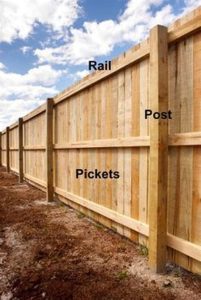Discover essential tips for proper fence installation, common mistakes to avoid, and the impact of tipping culture on quality in the industry.The fence installation industry plays a crucial role in enhancing property aesthetics, security, and privacy. However, the process of installing a fence isn’t as straightforward as it may seem; it requires careful planning and execution. Whether you’re a homeowner looking to enhance your outdoor space or a contractor navigating this dynamic market, understanding the intricacies of fence installation is essential. This blog post will delve into the importance of proper fence installation, key factors to consider beforehand, and common pitfalls to avoid. Additionally, we’ll explore the often-overlooked tipping culture within the industry and how gratuity can influence the quality of the work performed. Join us as we uncover the essential components of fence installation and the impact of tipping on this vital service.
The Importance of Proper Fence Installation
Proper fence installation is crucial for a variety of reasons, impacting both aesthetics and functionality. A well-installed fence enhances curb appeal and can increase the value of a property, making it an essential aspect for homeowners and businesses alike.
Moreover, a correctly installed fence ensures optimal security and privacy. It provides a physical barrier that deters intruders and keeps pets and children safe. If the installation is done improperly, it can lead to vulnerabilities that defeat the fence’s intended purpose.
Lastly, the longevity and durability of a fence heavily rely on its installation. Investing in professional installation can save you from costly repairs and replacements down the line. A solid foundation, proper materials, and adherence to local regulations are key components to consider in the installation process to ensure that your fence stands the test of time.
Factors to Consider Before Installing a Fence
When planning to install a fence, it’s essential to take into account several key factors that can significantly impact the success and longevity of your project. Understanding these factors will help ensure that your new fence meets your needs and adheres to any local regulations.
First and foremost, consider the purpose of the fence. Are you looking for increased privacy, security, or simply to mark boundaries? Different materials and designs serve different purposes, so decide on your primary goal before proceeding. For instance, a tall wooden fence provides more privacy, while a wrought iron option gives an aesthetic appeal with the visibility of your garden.
Additionally, be aware of your local regulations and zoning laws regarding fencing. Many areas have restrictions on fence height, materials, and placement, which could influence your choices. Checking with your local authorities helps avoid potential fines or the necessity to remove a non-compliant fence later on.
Lastly, consider the maintenance required for your chosen material. Some fences may need regular upkeep such as painting, staining, or sealing, while others, like vinyl or chain link, require minimal care.
Common Mistakes to Avoid During Fence Installation
Proper fence installation is crucial for both functionality and aesthetics. However, many homeowners make common mistakes that can lead to issues down the line.
- Neglecting to Check Local Regulations: Always ensure compliance with local laws and zoning regulations before installing your fence. Failure to do so may result in fines and having to remove or relocate the fence.
- Ignoring the Soil Conditions: Before digging, assess the soil type. Rocky or sandy soils can affect the stability of your fence. Consider hiring a professional to evaluate the ground if you’re unsure.
- Improper Measurement: Accurate measurements are essential for a successful installation. Always double-check your dimensions to avoid working with an uneven or incorrectly sized fence.
- Skipping Maintenance Planning: Consider how easy it will be to maintain your fence. Different materials require different levels of upkeep, so plan accordingly to avoid future headaches.
- Overlooking Neighboring Properties: It’s important to be aware of where your property ends and your neighbor’s begins. Prudent communication can prevent disputes and ensure a smoother installation process.
The best way to ensure a successful installation is to invest time in planning and preparation. Avoiding these common mistakes can save you time and money in the long run. Additionally, always consider consulting with professionals if you’re unsure about any part of the process.
By focusing on the details and adhering to local regulations, you can achieve a fence installation that meets both your aesthetic desires and practical needs. Remember, a well-installed fence not only enhances your property’s value but also provides crucial security.
In summary, foreseeing potential pitfalls and executing each step mindfully can lead to a successful fence installation. Make informed choices and be proactive to avoid these common errors.
Understanding the Tipping Culture in the Industry
Tipping in the fence installation industry can often be a topic shrouded in uncertainty and varying opinions. Many homeowners wonder whether tipping is appropriate and if it genuinely impacts the quality of service they receive. In this section, we will explore the nuances of tipping, including common practices and the implications it holds for both customers and installers.
In many service industries, including fence installation, tipping serves as a token of appreciation for hard work and quality service. While it is not a requirement, many clients feel inclined to tip when they are satisfied with the installer’s performance. The tipping amounts can vary widely, often ranging from 10% to 15% of the total installation cost, depending on the complexity of the job and the level of service provided.
Another critical aspect to consider is how tipping can influence the overall morale and motivation of the installers. When workers receive recognition for their hard work, it may encourage them to maintain high standards in their craftsmanship. Thus, tipping can serve as a motivational tool, fostering a culture of excellence within the fence installation industry. Ultimately, while tipping is a personal decision, understanding its context can help clients navigate tipping etiquette effectively.
How Tipping Impacts Quality of Fence Installation
Tipping in the fence installation industry can have significant implications for the overall quality of work. While it may seem like a mere gesture of appreciation, tipping often plays a crucial role in motivating workers and enhancing their performance.
- Motivation: Providing a tip can boost a worker’s morale, encouraging them to put forth their best effort during the installation process.
- Attention to Detail: A rewarding tip may lead to greater care being taken in measurements and workmanship, resulting in a sturdier and more aesthetically pleasing fence.
- Customer Relationships: Tipping can foster a positive working relationship between clients and installers, leading to better communication and a shared understanding of project expectations.
However, it is essential for customers to recognize that while tipping can incentivize quality work, it should not replace the necessity for professionals to adhere to high industry standards. Hiring well-reviewed and reliable contractors will ensure that quality is maintained regardless of tipping.
Moreover, tipping practices can vary by region and company; therefore, understanding local customs and expectations can help clients navigate these interactions. Ensuring that tipping is done appropriately can reinforce positive behaviors among workers, ultimately elevating the overall standard of fence installation across the industry.
In conclusion, while tipping is an important aspect, customers should not solely rely on it as a measure of quality.
Frequently Asked Questions
What are the key factors influencing the fence installation industry?
The key factors include demand for residential and commercial fencing, material availability, labor costs, and local regulations regarding property boundaries and zoning.
How has the fence installation industry evolved in recent years?
The industry has seen advancements in technology and materials, an increase in DIY projects, and a growing awareness of environmental sustainability, leading to more eco-friendly fencing options.
What are common types of fences being installed today?
Common types include wood, vinyl, chain link, aluminum, and composite fences, each chosen based on budget, aesthetic preference, and durability.
What role does customer service play in the fence installation industry?
Customer service is crucial, as it can significantly affect customer satisfaction and referrals. Excellent communication, timely project completion, and addressing concerns can lead to positive reviews and repeat business.
Is tipping customary in the fence installation industry?
Tipping is generally not expected in the fence installation industry, but it can be appreciated, especially if the workers exceed expectations or provide exceptional service.
What should customers consider when hiring a fence installation company?
Customers should consider factors such as the company’s reputation, experience, licensing and insurance, pricing, and warranties offered on the materials and workmanship.
What are the benefits of professional fence installation compared to DIY?
Professional installation ensures quality workmanship, adherence to local regulations, and often comes with warranties on materials and labor, reducing long-term maintenance issues that may arise from DIY projects.





